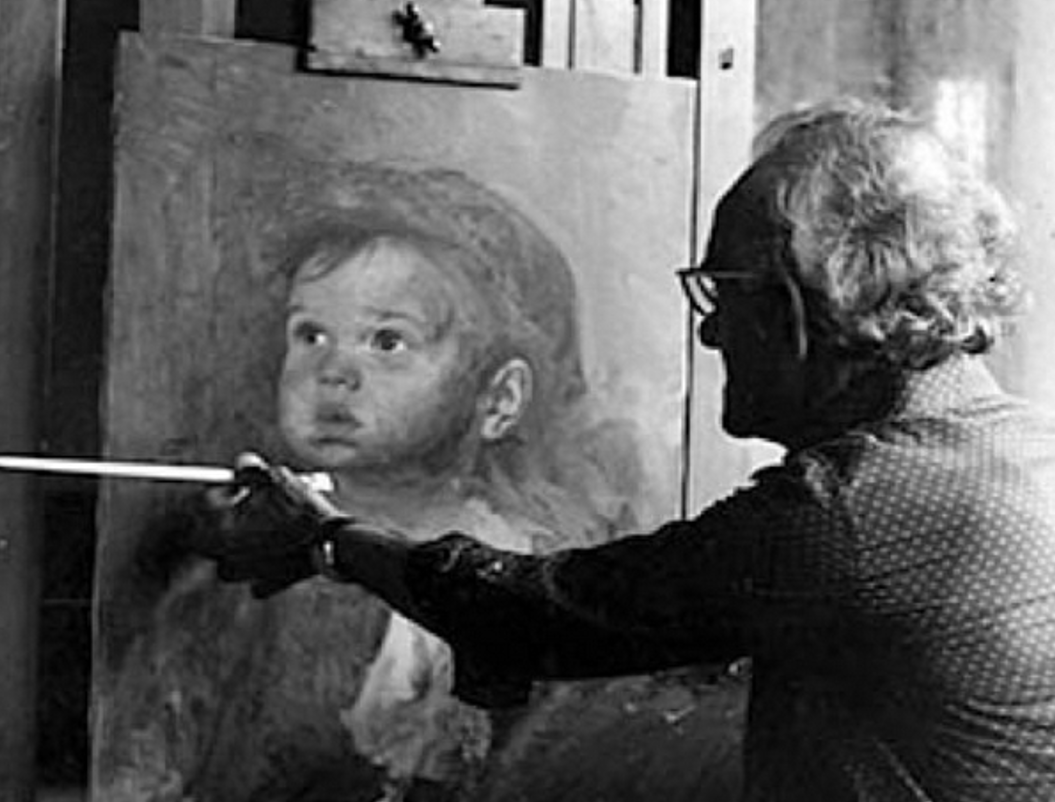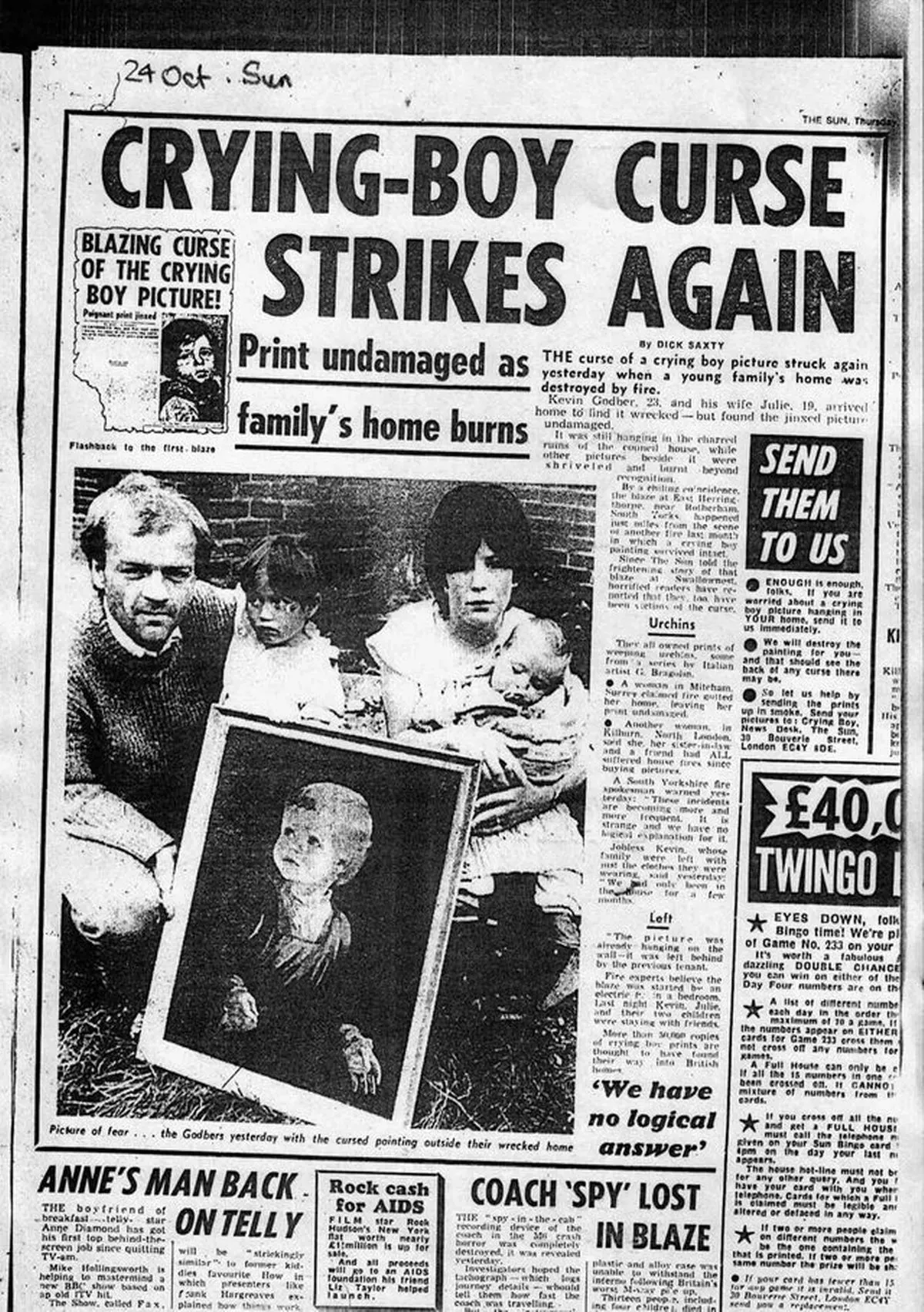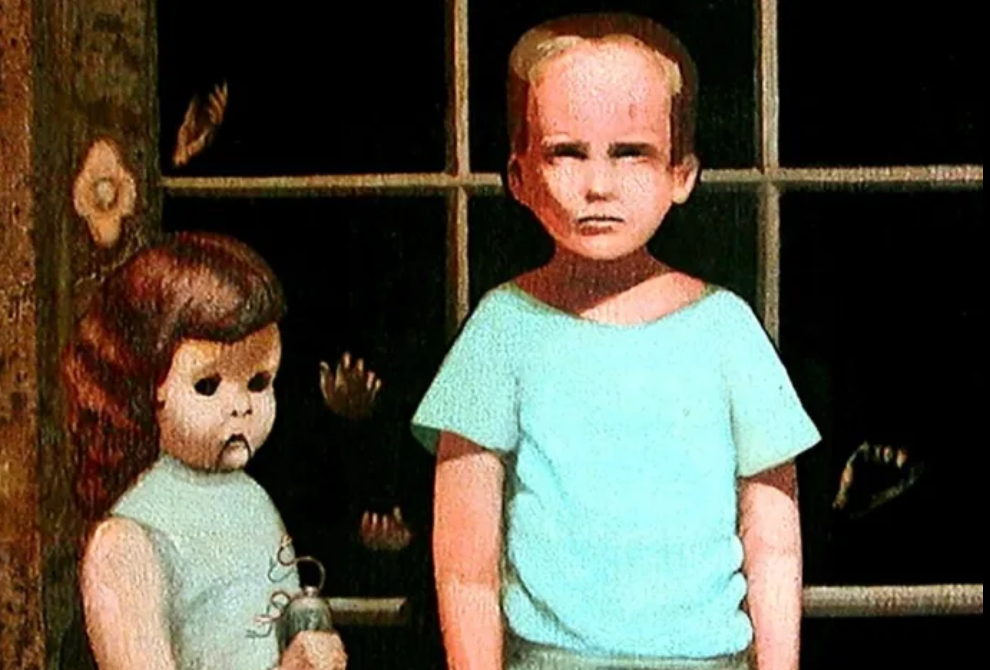Cursed Artworks: The Haunted Legend of the "Crying Boy" That Won’t Burn
What happens when a simple painting sparks fear and destruction? The legend of the "Crying Boy" paintings involves unexplained fires, paranormal suspicion, and psychological intrigue.

Imagine this: You’re sitting at home, glancing at a painting that’s hung on your wall for years. Maybe it’s a sentimental piece, or perhaps you just liked the way it fit the room’s decor. Then, one night, a fire breaks out. In the chaos, you notice something strange—the painting, the one you’ve always had, is untouched by the flames while everything else burns around it. The very image on your wall, seemingly innocent, becomes a symbol of something dark and unexplainable.
What would you do next? Would you destroy the painting, or would you dismiss it as a bizarre coincidence? What if, like many before you, you learned that the painting you cherished is believed to carry a curse—a curse that brings misfortune and mysterious destruction?
The legend of "The Crying Boy" painting raises these unsettling questions. The chilling stories of homes consumed by fire, with only this particular painting left unscathed, prompt us to question whether these events are just urban myths or something more sinister. As you read through this haunting tale, take a moment to reflect: What would you do if a simple work of art carried with it the weight of a curse?
This is the kind of psychological mystery that has surrounded "The Crying Boy" for decades, igniting fear and curiosity.
As the Halloween season looms, it’s time to turn our gaze towards the eerie and unsettling corners of the art world, where stories of haunted paintings and cursed creations continue to spook even the most skeptical. For this episode of Cursed Artworks, we’re diving into one of the most infamous—and widely feared—art legends of the 20th century: "The Crying Boy" paintings.
This tale isn’t about a single cursed artwork, but rather an entire series of portraits that inexplicably survived house fires and left a trail of destruction behind them. The legend of "The Crying Boy" paintings is more than just a curious urban myth—it’s a chilling reminder that even the most innocent-looking art can take on a life of its own.
The Haunted Beginnings of "The Crying Boy" Legend
It all began innocently enough. In the 1950s and 1960s, Italian artist Giovanni Bragolin, under the pseudonym Bruno Amadio, created a series of mass-produced paintings featuring young children with large, sorrowful eyes and tear-streaked cheeks. The paintings were simple but emotive, their subjects often staring directly at the viewer. These prints, known as "The Crying Boy" series, became wildly popular in post-war Europe, especially in the United Kingdom. In an era still haunted by the traumas of war, these melancholic images found a place in many homes, perhaps reflecting a shared sense of loss and vulnerability.
However, it wasn’t long before these paintings became notorious for something far more sinister than their melancholy subject matter.

A Curse Ignites: The Mysterious Fires of the 1980s
By the mid-1980s, reports began to emerge that homes containing "The Crying Boy" paintings were catching fire under mysterious circumstances. Worse still, firefighters reported a baffling detail: while entire homes were reduced to ashes, the paintings remained inexplicably untouched by the flames.
The first widely publicized instance of the curse came in 1985, when The Sun, a British tabloid, ran a chilling headline: "Blazing Curse of the Crying Boy Picture!". The article recounted the story of a fireman in Yorkshire who claimed to have witnessed numerous fires where the only undamaged item in the charred ruins was a "Crying Boy" painting. According to reports, in some cases, the entire wall around the painting had been scorched black, but the artwork remained eerily intact.
Soon, readers across the UK began coming forward with their own terrifying tales. More and more homes that displayed "The Crying Boy" painting had mysteriously gone up in flames, and the owners were quick to attribute the cause to the cursed image. The media frenzy reached its peak when The Sun encouraged frightened homeowners to send in their "Crying Boy" prints, which the paper promised to burn in a mass bonfire. Thousands of copies were reportedly destroyed, but the legend of the cursed paintings only grew stronger.
The Power of Media and the Birth of a Legend
While the paranormal elements of the Crying Boy legend captured the public’s imagination, the media played a pivotal role in spreading the curse narrative. The Sun tabloid, known for its sensational headlines, was instrumental in fueling the story’s wildfire spread across the UK. Stories about the painting quickly escalated, with readers contributing eerie accounts of unexplained fires they linked to the artwork. The 1980s saw a resurgence in supernatural fascination, making the public particularly receptive to stories like the Crying Boy curse.
This era was a golden age for ghost stories, UFO sightings, and haunted objects. Popular television shows, books, and films increasingly delved into themes of the paranormal, reflecting a broader cultural curiosity about the unknown. The Crying Boy paintings, with their emotionally charged imagery, became an ideal target for a society hungry for the supernatural. Much like modern internet phenomena, the legend took on a life of its own, feeding off public fear and the irresistible thrill of a curse.
In this climate, the Sun and other tabloids thrived by amplifying public fears, merging fact with speculation to create stories that captivated—and often frightened—their readers. The 1980s’ appetite for mystery and fear ensured that the Crying Boy became not just an urban legend, but a cultural phenomenon, blending art with the supernatural in a way that continues to fascinate today.
Psychological or Paranormal? The Explanations Behind the Curse
Despite the dramatic stories of unexplained fires, skeptics and psychologists have offered more rational explanations for the "The Crying Boy" phenomenon. One of the most common theories involves the varnish used on the prints. Some experts suggest that the paintings were coated with a fire-retardant varnish, which could explain why they survived when everything else around them was destroyed.
On a psychological level, the curse may also be attributed to confirmation bias—the tendency for people to remember details that confirm their existing beliefs. Once the idea that "The Crying Boy" paintings were cursed took hold, homeowners who experienced fires were quick to attribute their misfortune to the painting, further fueling the legend.
Additionally, the disturbing imagery of a crying child may have played a significant role in how people interpreted the painting’s presence. The sight of a distressed child triggers deep emotional responses, particularly feelings of sadness, fear, or vulnerability. These emotions, combined with the eerie circumstances of the fires, may have heightened people’s fear of the painting, creating a perfect storm of superstition.
Related Stories:


Cultural Fascination: Why Was "The Crying Boy" So Popular?
It’s important to understand why "The Crying Boy" paintings were so widely embraced before they were feared. In post-war Europe, particularly in the United Kingdom, the image of a sorrowful child resonated with families who had endured years of hardship. The emotional vulnerability depicted in these paintings likely mirrored the collective trauma of a generation that had faced loss, displacement, and uncertainty during the war years.
The art was sentimental, offering a glimpse of innocence and sadness that many people found both comforting and familiar. It was affordable, mass-produced art for the everyman, and its widespread availability ensured that nearly every street in Britain had at least one home with a "Crying Boy" hanging on the wall.
Where Are The Paintings Now?
Though thousands of Crying Boy paintings were reportedly destroyed during the height of the curse panic, many copies still exist, particularly on online auction sites. Today, the cursed reputation has become part of the painting’s appeal, attracting both skeptics and paranormal enthusiasts alike. For some collectors, owning a Crying Boy painting is akin to holding a piece of paranormal history, a curiosity that invites conversation and speculation. Others, especially those fascinated by the supernatural, see it as a rare artifact with a dark past, adding an eerie thrill to their collections.
The painting has also found a niche among collectors interested in “cursed” or haunted objects, as its legend continues to evolve in modern culture. Whether they view it as a reminder of media-fueled hysteria or as a true bearer of misfortune, the Crying Boy endures as an artifact that transcends its original artistic intent, living on as a symbol of humanity’s fascination with the inexplicable.
The Lasting Legacy of "The Crying Boy"
Whether you believe in the paranormal or not, the legend of "The Crying Boy" endures as one of the most captivating art-related mysteries of the modern era. It’s a testament to how media sensationalism, psychological fear, and superstition can combine to transform a simple painting into a cultural phenomenon.
As the Halloween season approaches, the story of "The Crying Boy" reminds us that the scariest stories are often those rooted in the familiar—an innocent painting, a common home, and an inexplicable curse that refuses to die.
Stay tuned for the next episode of Cursed Artworks, where we’ll explore another spine-chilling piece of art that has terrified and captivated audiences for decades.
ART Walkway News






